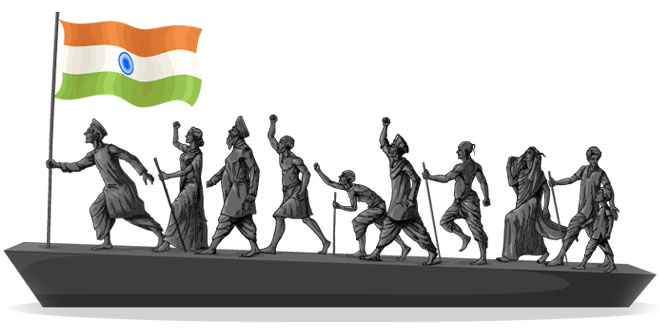Question: Why for a long time, the Congress had ignored the daiits?
What role did Gandhiji play in uplifting them?
Or
How did Gandhiji view the Dalits? What did he do for them?
Answer: For long, the Congress had ignored the daiits, for the fear of offending the Sanatanis, the conservative high-caste Hindus. But Mahatma Gandhi declared that Swaraj would not come for a hundred years if untouchability was not eliminated. Under his constructive programme he laid stress on the removal of untouchability. He called them (untouchable) the harijans – meaning the children of God. He also organised satyagraha to secure their entry into temples, and access to public wells, tanks, roads and schools. He himself toured their colonies, and even lived there. He even cleaned toilets to dignify the work of the sweepers.
Question: Explain the role of Ambedkar in uplifting the dalits or the depressed classes.
Answer:
- Dr Bhim Rao Ambedkar was of the opinion that only political empowerment would resolve their problems of social injustice.
- Due to his efforts, Dalits began organising themselves, demanding reserved seats in educational institutions and separate electorate that would choose the dalit members for legislative councils.
- In 1930, Ambedkar entered national politics. In the same year, he organised the Depressed Classes Association to make them politically more strong.
- He was nominated as a delegate of the oppressed classes for the Second Round Table Conference. In that Round Table Conference, he clashed with Mahatma Gandhi by demanding separate electorates for dalits.
- He demanded a separate electorates for dalits. To give them political power he signed Poona Pact. The Poona Pact gave the depressed classes reserved seats in provincial and central legislative councils.
Question: When and why was the Poona Pact signed?
Or
Examine the background of the Poona Pact of 1932 in the light of differences between Gandhiji and Dr. B.R. Ambedkar.
Examine the background of the Poona Pact of 1932.OrDescribe the main features of ‘Poona Pact’
Answer:
- Dr Bhim Rao Ambedkar was nominated as a delegate of the oppressed classes for the Second Round Table Conference.
- In that Round Table Conference, he clashed with Mahatma Gandhi by demanding separate electorates for the dalits.
- When the British government accepted Ambedkar’s demand, Gandhiji began a fast unto death. He believed that separate electorates for dalits would slow down the process of their integration into society. The issue was eventually resolved through the.
- Poona Pact of September 1932.
- It gave the Depressed Classes (later to be known as the Scheduled Castes) reserved seats in provincial and central legislative councils, but they were to be voted in by the general electorate.
Question: Analyse any four features of Gudem rebellion of Andhra Pradesh.
Or
Explain the main features of Gudem rebellion.
Or
Describe the contribution made by Alluri Sitaram Raju to the Non-Cooperation Movement in Andhra Pradesh.
Answer:
- The Gudem rebellion spread in response to the Non Cooperation Movement in 1921.
- In the Gudem Hills of Andhra Pradesh, a militant guerrila movement spread in the early 1920s under the leadership of Alluri Sitaram Raju Against forest laws.
- The rebels proclaimed that he was an incarnation of God as he could make correct astrological predictions and heal people.
- Raju talked of the greatness of Mahatma. Gandhi and was inspired by Non Cooperation Movement, and persuaded people to wear Khadi and give up drinking.But at the same time he asserted that India could be liberated only by the use of force.
- The Gudem rebels attacked police station, attempted to kill British officials and carried on guerrilla warfare for achieving swaraj. Raju was arrested and executed in 1924
 Class Notes NCERT Solutions for CBSE Students
Class Notes NCERT Solutions for CBSE Students





